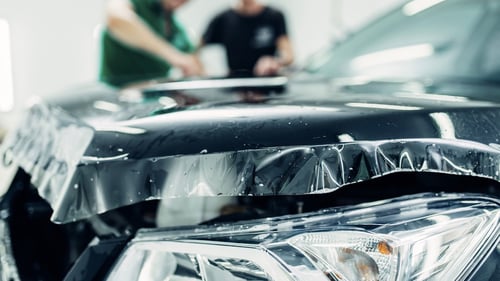Not all automotive adhesives are created equal.
Premium materials can require a substantial investment, but their advantages may be lost in applications that don’t take advantage of premium features. On the other hand, one of your economical options may provide excellent quality for interior or decorative purposes, but might be unable to stand up to the stresses on high-impact areas of the vehicle or the heat of an engine compartment.
Whether you’re setting a budget or trying to meet a target price point for automotive films, there are a few primary factors that will guide you toward the ideal adhesive for your purpose. The thickness of an adhesive film, bonding strength of the adhesive layer, and volume of your total purchase can all affect the final price per unit that your supplier can offer.
Here are your biggest budget considerations when purchasing pressure-sensitive adhesive tapes and films:
One Material, Multiple Price Points
Even a chemical composition for automotive films or tapes comes in at a different price, depending upon how thick you want the material. A 1-millimeter thick film can be virtually invisible and contour smoothly to uneven surfaces, but a 3-millimeter film offers more robust resistance to scratches and environmental hazards.
Each film has its advantages, but you can anticipate that more material will mean a higher cost. The difference in price—not just properties—will need to weigh in your budget considerations. You may find that, in the end, it makes sense to go with a different 1ml or 3ml material if the one you preferred at another thickness doesn’t align with your budget at the thickness you need.
Impact of Adhesive Specs
The overall cost of automotive interior films will be impacted by the makeup of the adhesive layer(s) required for your project. Adhesive costs can vary with the substrates they will need to bond and the level of strength that is necessary for their purpose. With double-sided pressure-sensitive tapes, you may even need two different adhesives—one suited to the substrate on each side of the tape.
A protective wheel film doesn’t require permanent-strength adhesives since it is expected to release easily and cleanly. A label in the engine bay, by comparison, must withstand incredible heat and fluctuating temperatures. Since the cost of the adhesive layer may be relative to its durability, your needs could ultimately sway you towards a different core or backing material to accommodate your price target.
Price Targets Matter
If you come to a supplier with a price target in mind, it can help that supplier to make suggestions that will cater to your needs without exceeding your spending goals. Adhesive suppliers have vast catalogs of material options, and a budget goal can narrow down the sea of options and save you time. Suppliers can showcase a handful of the most relevant adhesives and discuss their comparative strengths without devoting effort to options that would likely fall far above or below your target numbers in a final quote.
It will also help you meet your price target per unit if you can buy automotive films in bulk. A large-volume order helps a supplier give you their best possible price because it improves the value of retooling, stocking, and designing materials for your order. This saves both you and your supplier money in the long run—gains you can pass on to an OEM.
The best way to get a clear indication of how all these factors will affect your budget is to reach out to a reputable adhesive film supplier for answers. You can use consultations to discuss how volume, substrates, and properties can impact the costs of your automotive films.

